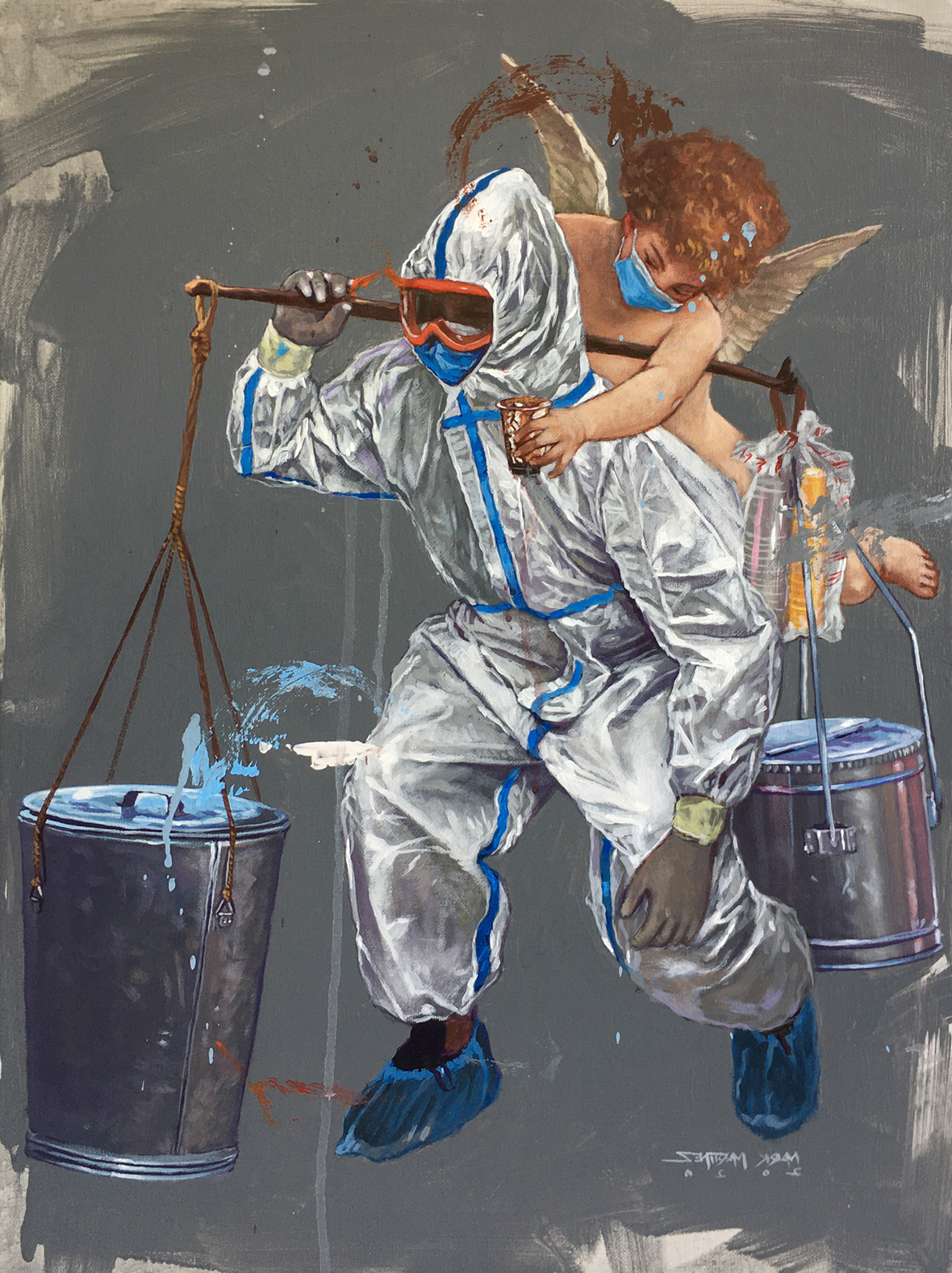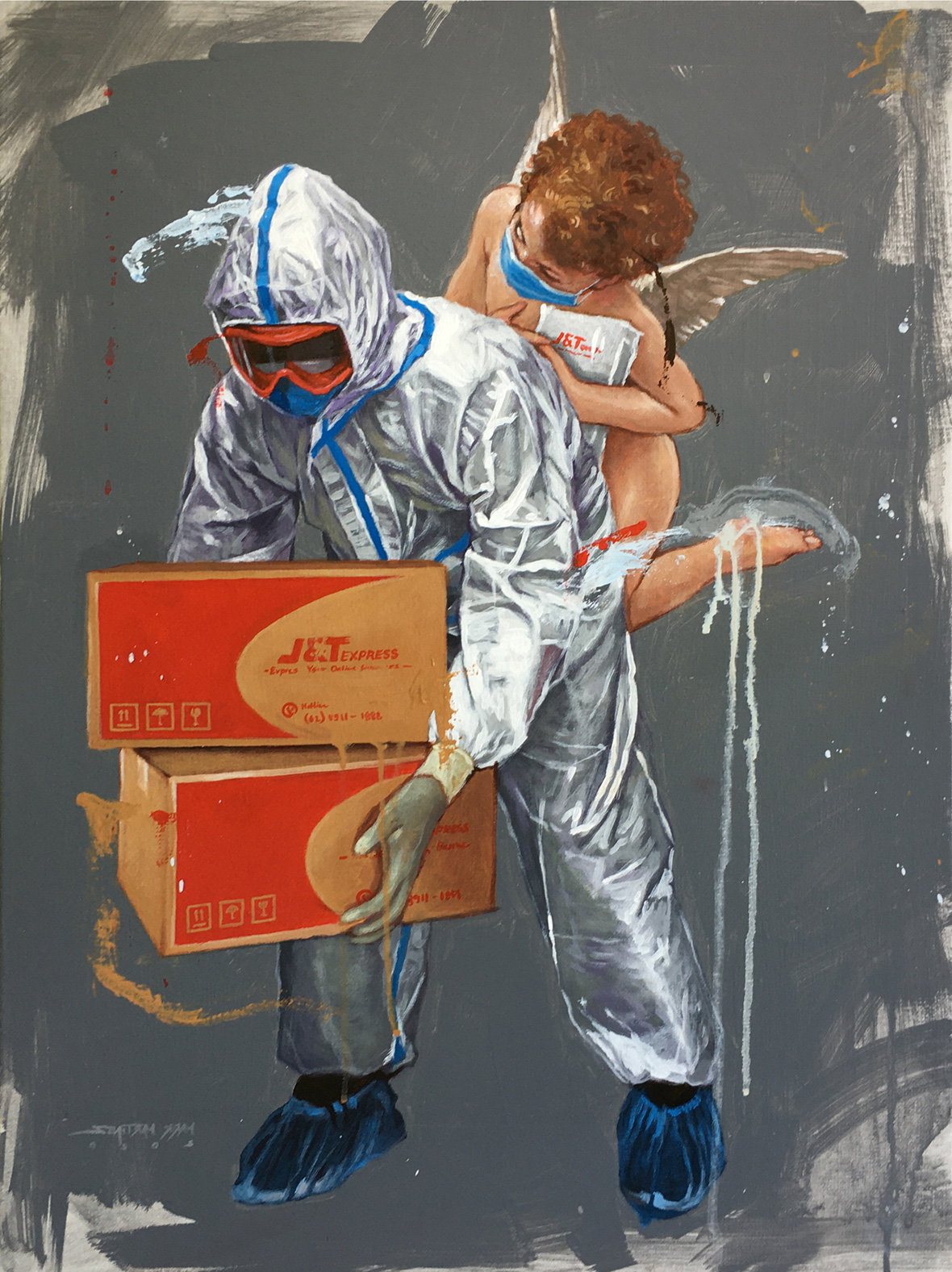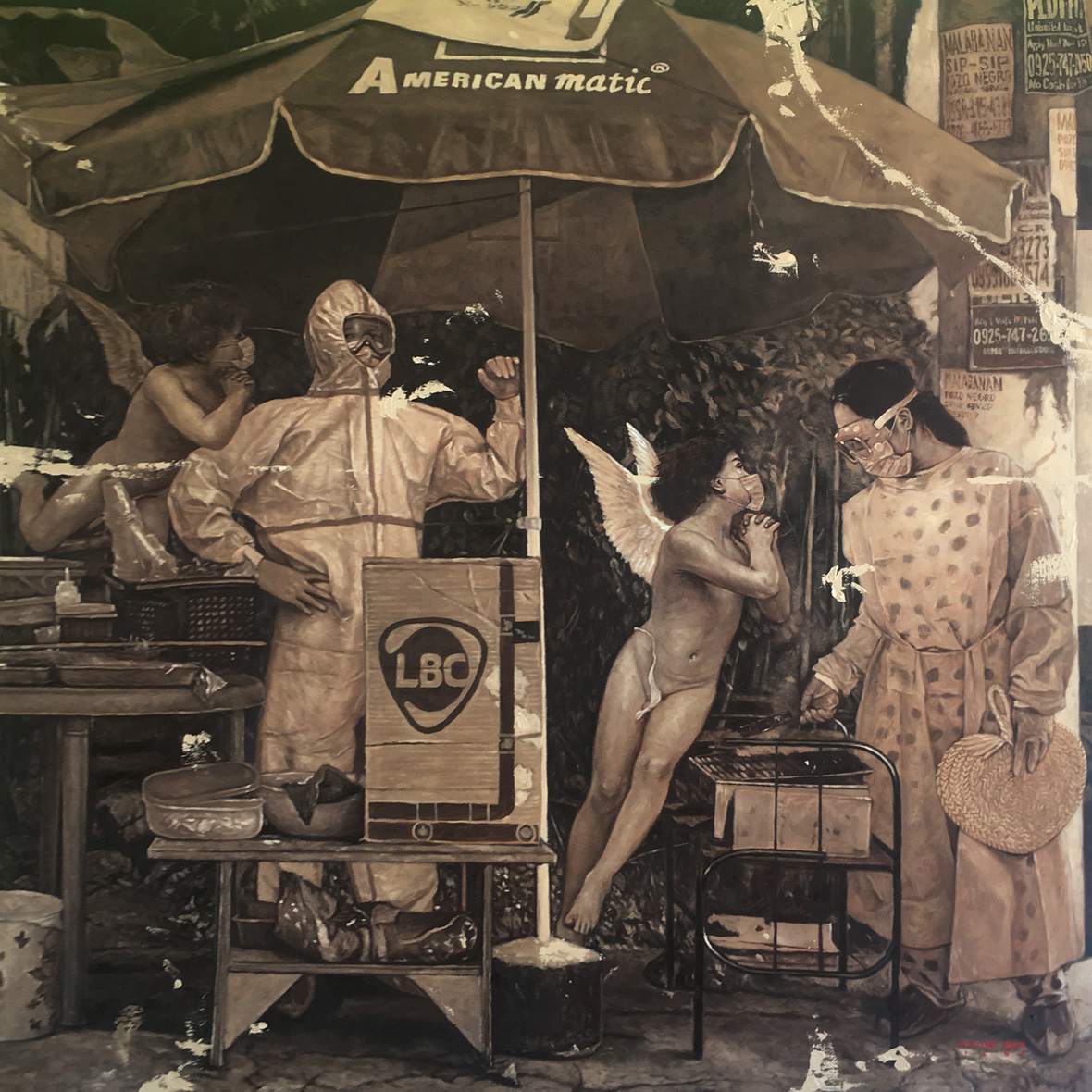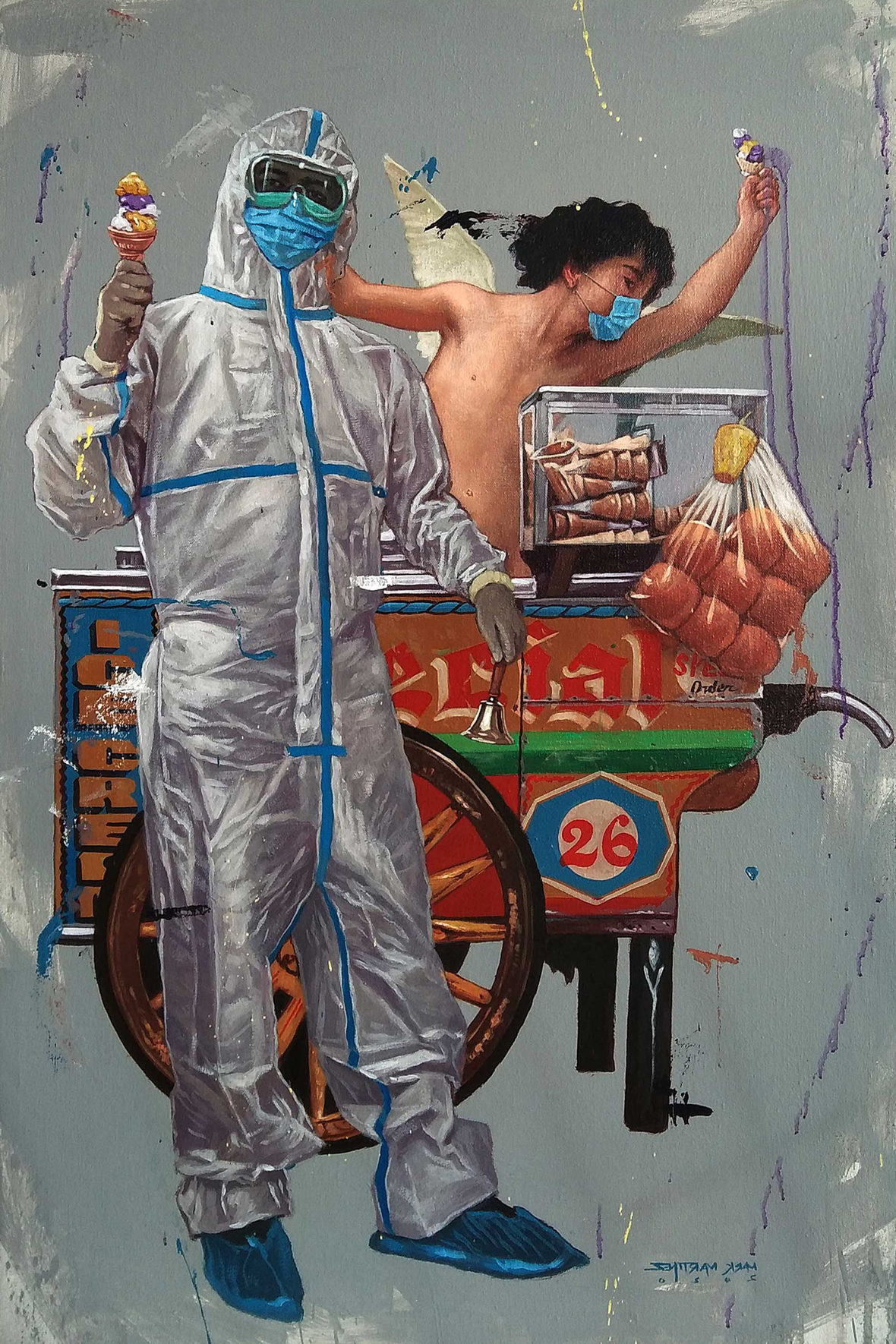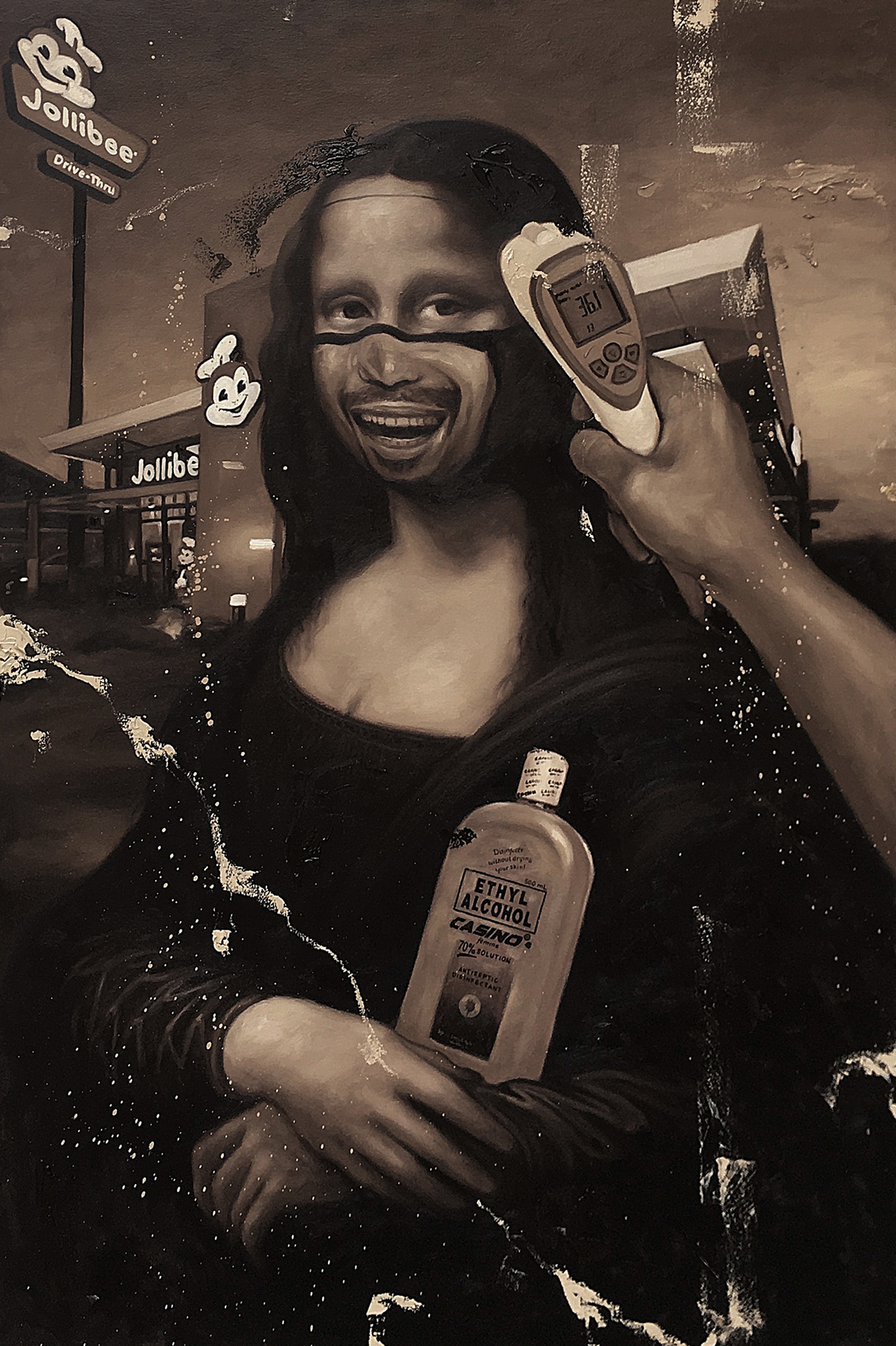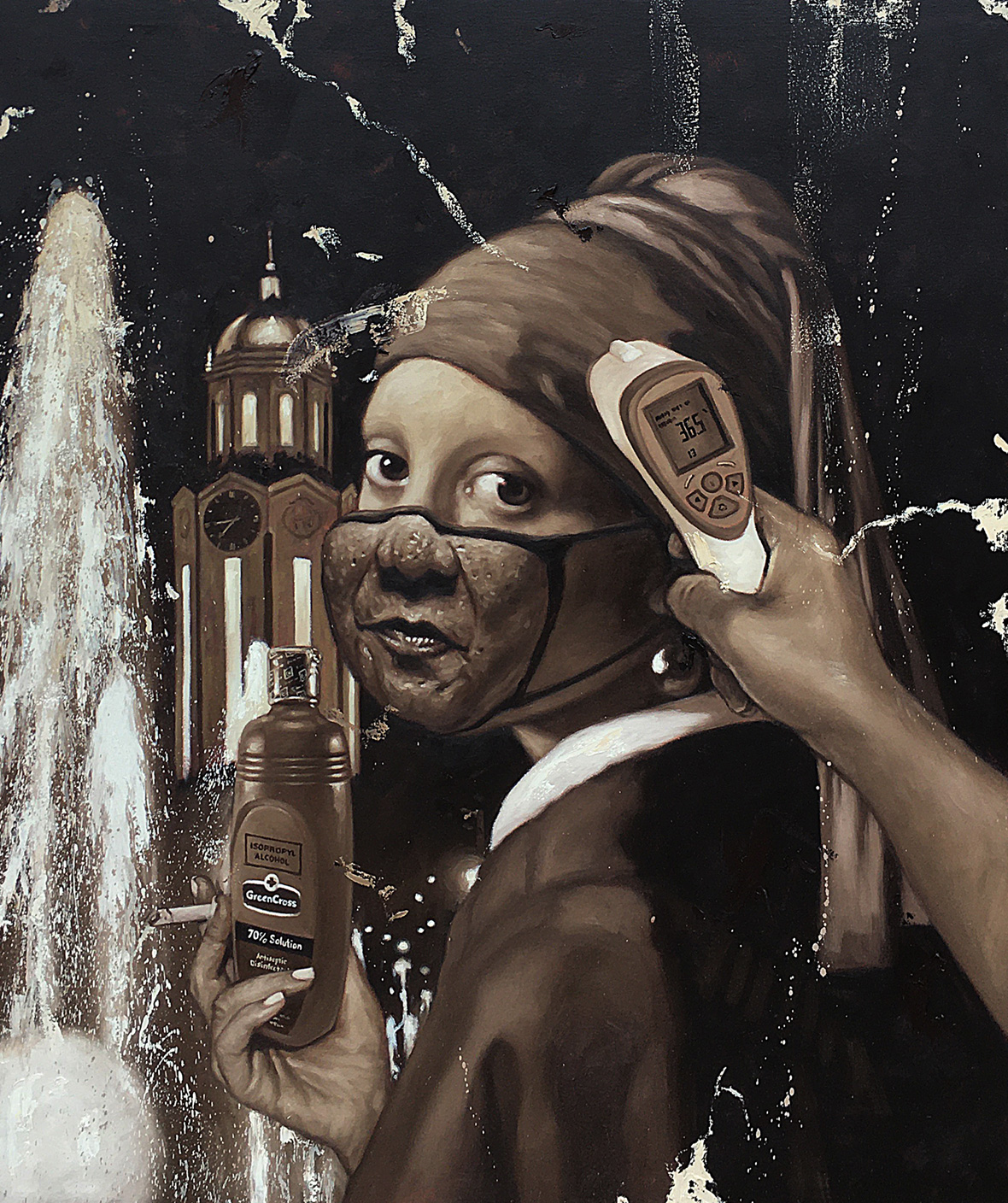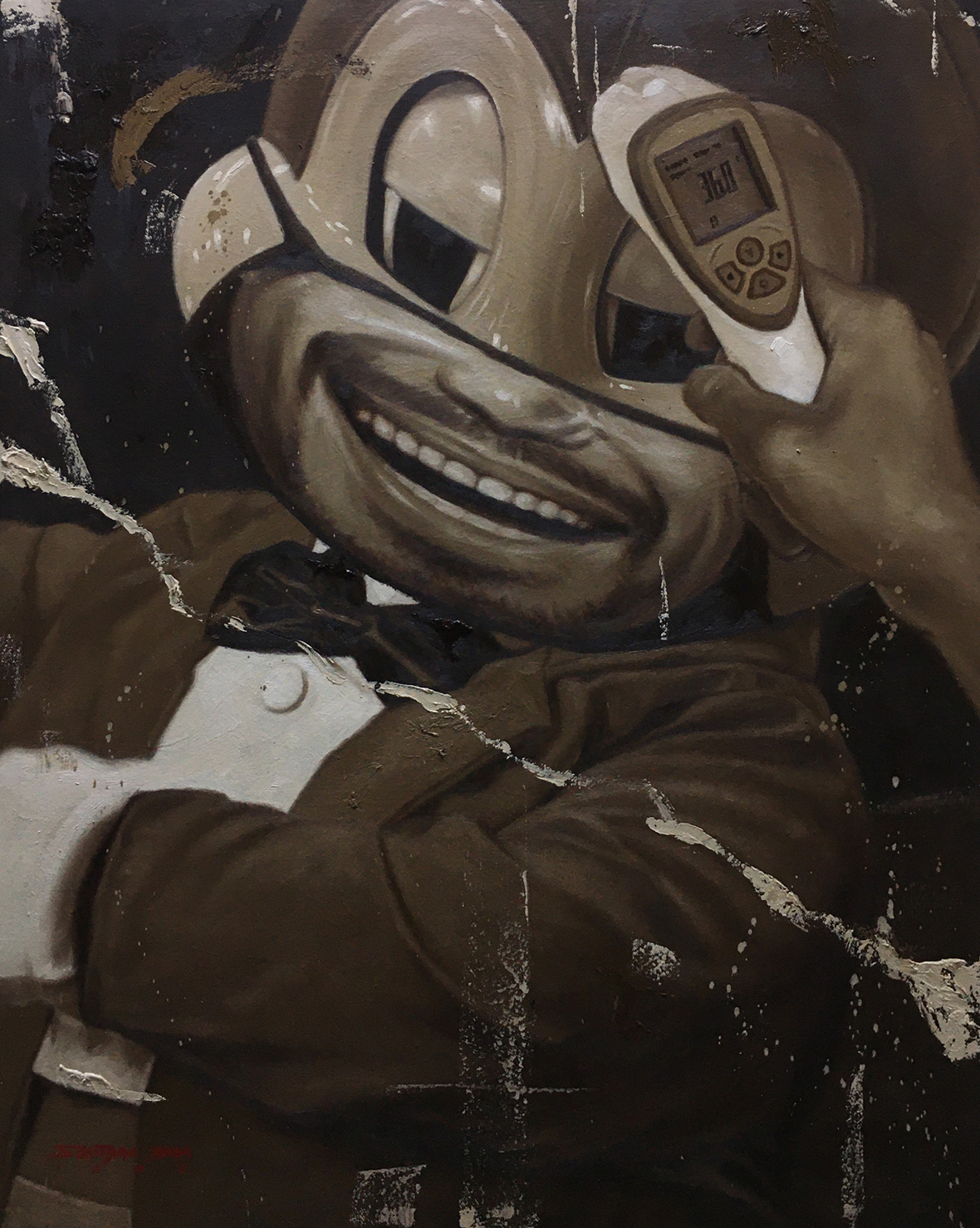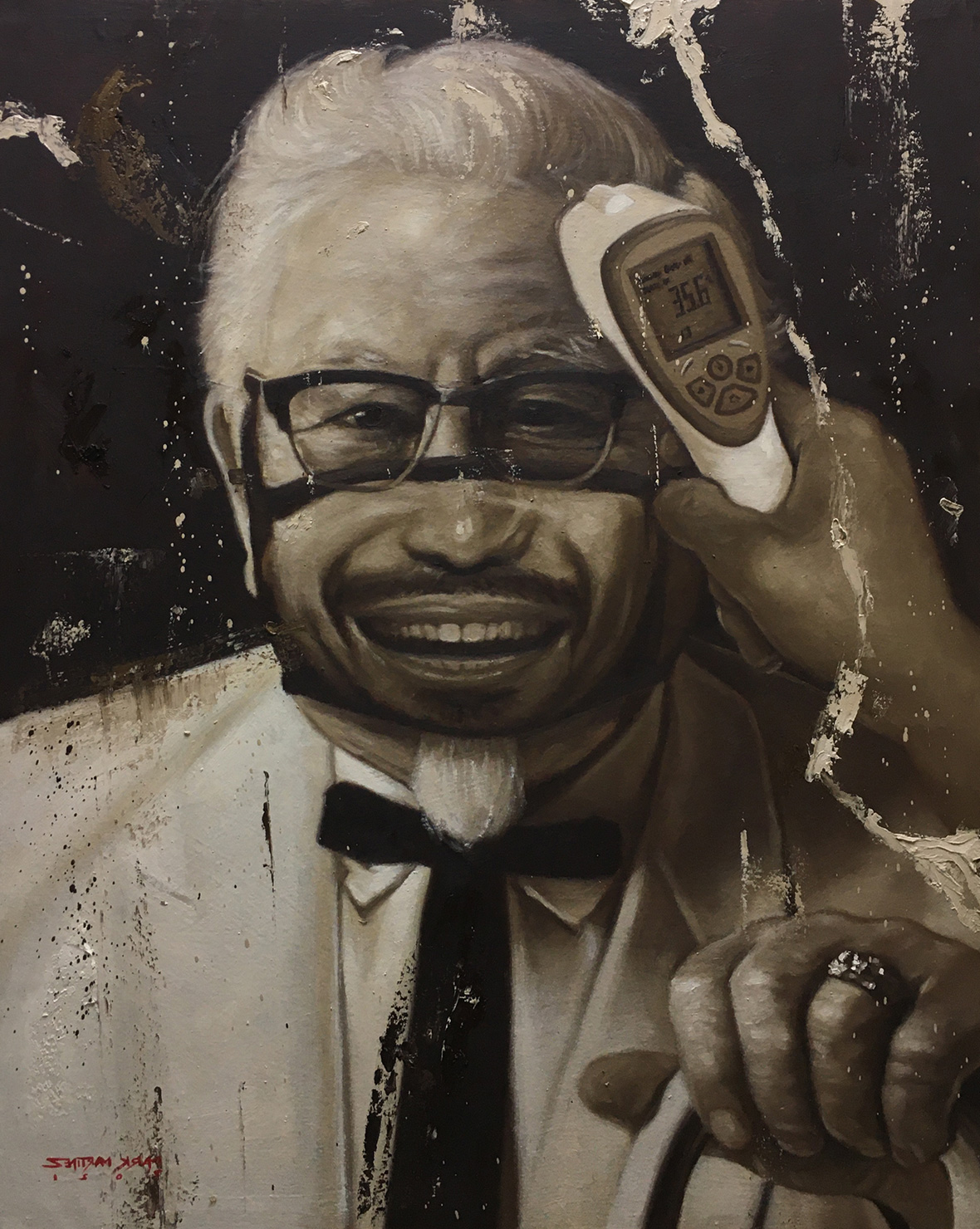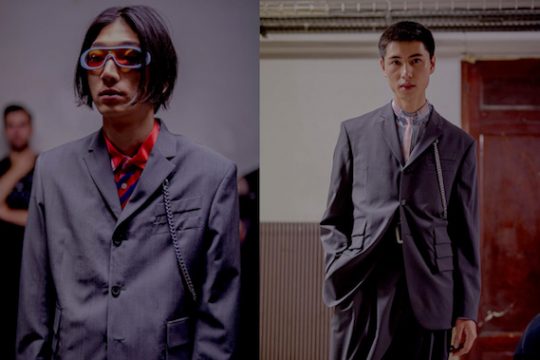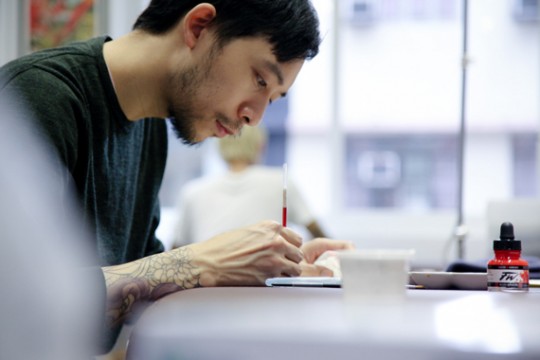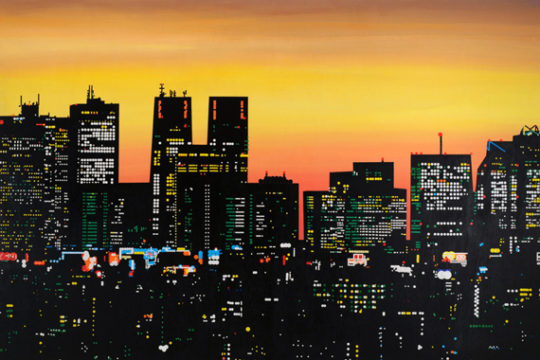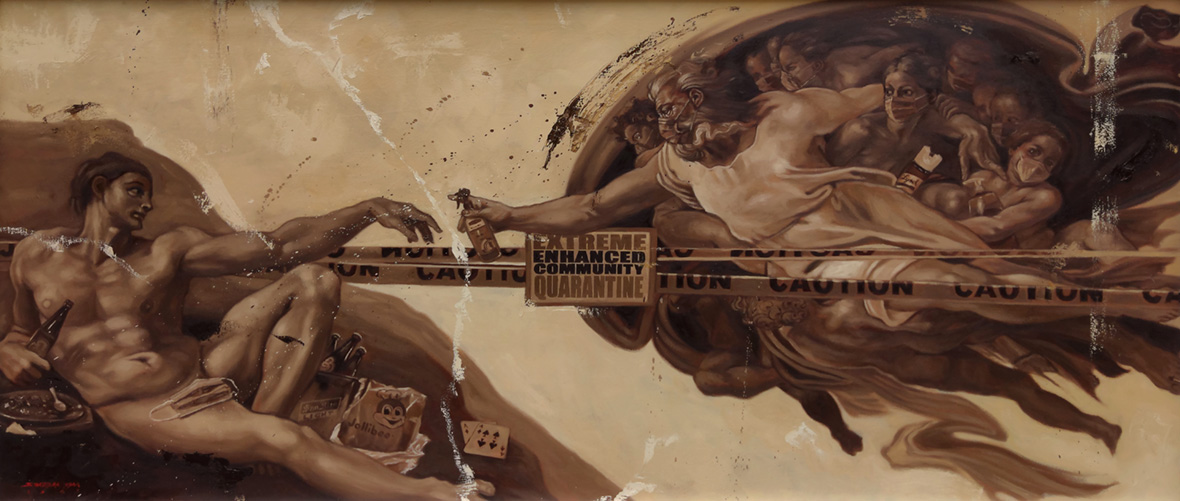
The pandemic has affected everyone to varying degrees, and people have found different ways to cope. One method is the ability to find humor even in dark times. The oil paintings of Filipino artist Mark Martinez do precisely that. While his artwork has long dwelled on less than glamorous settings, they’ve always contained a healthy dose of levity. His recent work surrounding the lockdowns, virus outbreaks, and economic crises in the Philippines is no exception.
我们每个人对待事情的态度不尽相同。即便在至暗时刻,也有人喜欢以轻松幽默的方式来对待。菲律宾艺术家 Mark Martinez 在疫情期间与油画作伴。他的作品主题向来严肃,但不乏几分诙谐与幽默,他最近以菲律宾封城、疫情爆发和经济危机为主题创作的一系列作品就是很好的例证。
Martinez’s COVID series builds on his usual cast of characters, which places classical European motifs into everyday Filipino scenes populated by regular people and familiar signage. Only now, his characters are fully dressed in PPE, and many scenes take place in uncomfortable hospitals and virus testing centers. Typical forms of pandemic theater, such as infrared thermometers, also make regular appearances. “Despite the fact that history’s repeating itself, I think this pandemic has brought out the best and worst of us, and definitely tested our faith,” he says
Mark 喜欢绘画肖像,COVID 系列同样围绕人物展开;与此同时,在菲律宾日常场景中穿插各种经典欧洲艺术元素,是他一贯的创作方式。只不过这一次,角色们都身穿个人防护服,场景也大部分发生在医院和病毒检测中心,这些在深沉的色调下令人惴惴不安。仔细观看,红外线温度计等医疗常见的物品屡见不鲜。他说到:“虽然历史不断重演,但我觉得这场疫情暴露出了人们最好和最坏的一面,时刻考验着我们的信仰。”
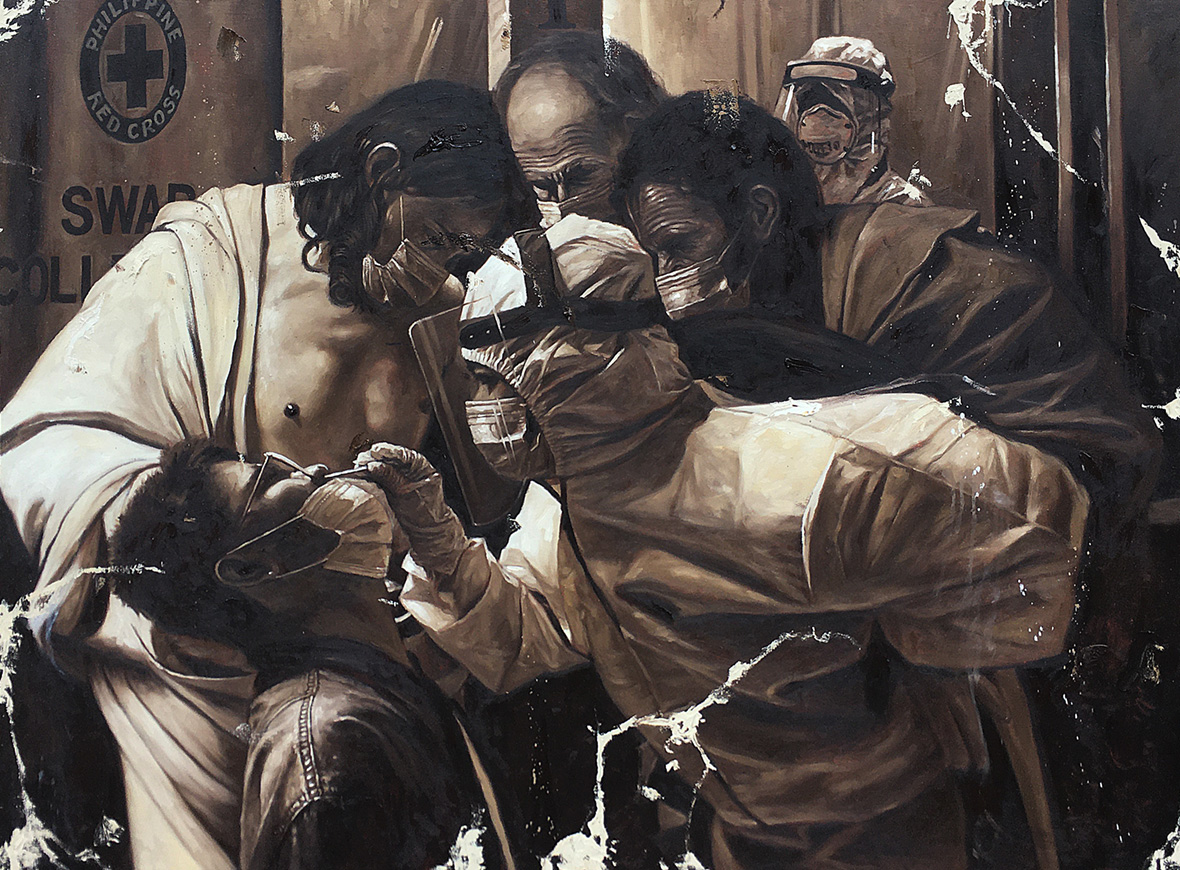
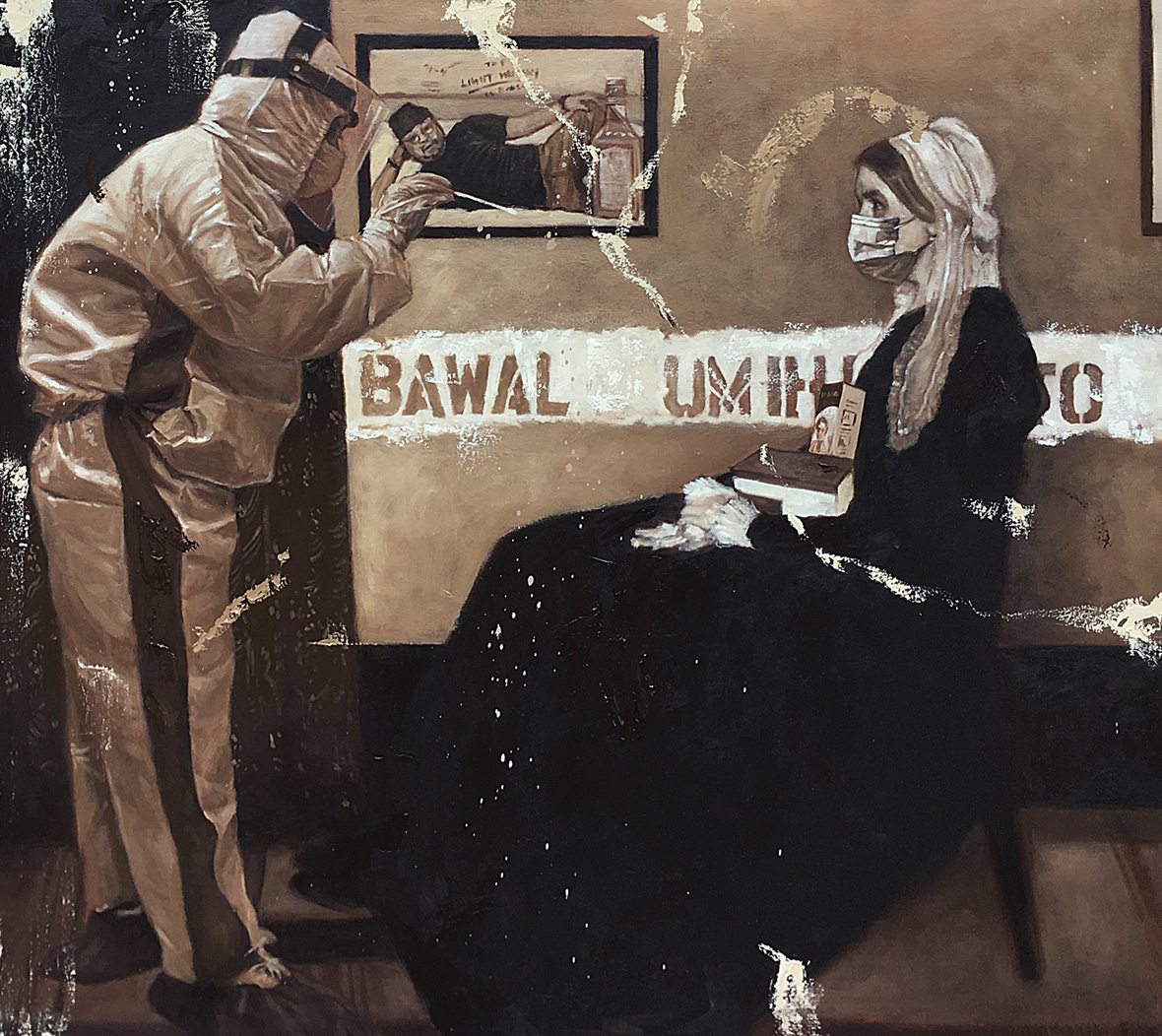
He’s from Bulucan, a province just north of Metro Manila, and got an early start with art. By the fourth grade, he was already drawing editorial cartoons. “That’s been a huge influence on my work, to this day,” Martinez says. He continued cartooning through high school, and eventually enrolled in a fine-arts program at university. His graduation and success as an artist are something of a victory for his family, since he had two uncles who both enrolled in art school but had to drop out in order to support their families.
Martinez settled on his current style while still in college. “I joined painting competitions using old photos as references, eventually including old and classical paintings,” he recalls. “I combined them with objects or everyday scenes that I witnessed around me. I wanted to make a new story out of them that my fellow Filipinos could relate to.”
Mark 来自马尼拉大都会以北的布卢坎省,很早就接触艺术,才十几岁,便开始尝试“社论漫画”(Editorial Cartoons)。他表示:“直到今天,这对我的创作仍然有着深远的影响。”高中期间,他继续创作漫画,后来大学又入读了美术专业。对他的家人来说,他能够顺利毕业并成为一名艺术家就是一种胜利,因为他的两个叔叔都曾入读艺术学校,但为了养家糊口不得不退学。
他如今的创作风格,早在大学时期便扎下了根基。“我参加绘画比赛,以旧照片为素材,揉进一些经典画作元素,将这些与日常所见的事件或场景相结合,从中讲述全新的故事,一些菲律宾人能产生共鸣的故事,”他回忆道。
The cast of characters in his work is consistent, ranging from cherubic angels and Biblical figures to fast-food workers, street vendors, and jeepney drivers. These characters are depicted while making inuman, singing karaoke, or getting sloppy at a restobar—once-typical forms of social gatherings that are regularly off-limits due to the pandemic. Familiar Filipino iconography in the form of ubiquitous corporate logos are splashed across his work as regularly as they’re seen in every corner of the country. Martinez says he has neutral feelings towards these logos—they simply exist. But he says the fact that Western classical art is more recognizable than the work of local artists bothers him: “Most Filipinos find foreign stuff more appealing or interesting, it doesn’t matter whether it’s a human being, a shoe, or a song. This may be hard to accept, but it’s the reality nowadays.” Repurposing classical paintings is quite common in the Philippines, with several artists, including Martinez, using Girl With A Pearl Earring specifically.
他作品里的角色阵容很一致,基本上都是小天使、圣经角色,以及快餐店工人、街头小贩和吉普尼司机,他们一边喝酒,一边唱卡拉 OK 或在餐吧里买醉——这些曾经常见社交聚会场景,如今却由于疫情而被禁止。画面中还常常出现各种熟悉的菲律宾元素——随处可见的公司标志和招牌。Mark 对这些标志持中立态度,但令他介怀的是,在当地,西方古典艺术往往比本地的艺术家作品更具有辨识度:“大多数菲律宾人都觉得洋人的东西更有吸引力或有趣,不管是人、鞋子或是音乐。这总令人很反感,但这就是事实。”对于菲律宾的艺术家来说,这种在作品中融入西方古典画作元素的创作方式十分常见,而包括 Mark 在内的好几位艺术家对此情有独钟。但其背后的寓意绝非肤浅,往往具有深刻含义。
Despite the pandemic, life goes on, even if it’s drastically different in some ways. Many of the scenes and people Martinez has been known to paint still appear, just now weighed down under new burdens. “I want to show how important our frontliners are; to show appreciation for their daily sacrifices just to serve their fellow countrymen no matter how dangerous it is for themselves and their families,” he says of his newer works. This includes minimum wage workers delivering and serving fast food and street food, not just health workers. “These workers were overlooked at the beginning of the pandemic. That’s why I dress them in PPEs, to emphasize that they are indeed frontline workers. As time went on, people here have definitely started to appreciate them more.” His paintings of the Jolly Bee and Colonel Sanders covered in face masks while being scanned for fever are for the same purpose, as a way to highlight the fast-food workers who’ve lost their jobs or have to risk their safety to keep working. He often adds angels to these paintings as an offering of protection of sorts.
疫情尚未结束,但生活仍要继续,即使在某些方面可能已不同往日。Mark 常画的那些场景和人物依旧生生不息,只是它们被疫情压得喘不过气来。提及新作,他说:“我想把作品献给前线的医护人员,感谢他们的付出,以及每天为广大群众所作出的牺牲。”不只是前线的医护人员,也包括拿着微薄的工资,运送和提供快餐和街头食物的工人。“疫情期间,这些群体一直被人们所忽略,我在画中给他们穿戴防护装备,强调他们也是前线的一份子。不过,现在有越来越多的人意识到了他们的付出与贡献。”同样,他画的快乐蜂(菲律宾的餐饮品牌)和肯德基爷爷佩戴口罩接受测温,这是为了突出那些失去工作或不得不冒着风险继续工作的快餐店员。他还融入了天使,寓意着呵护与保佑。
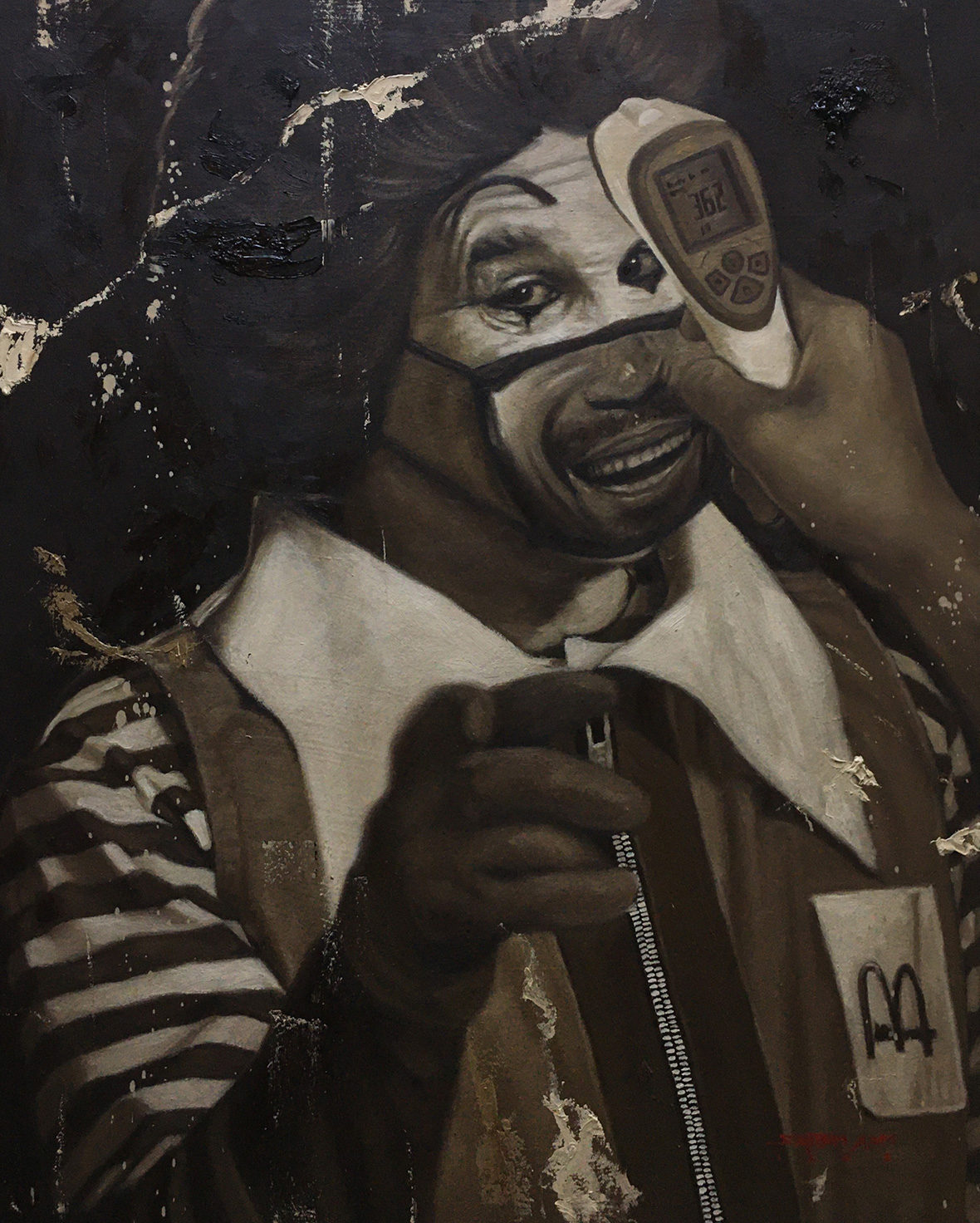
One common object in the new series is a face mask with the lower half of boxer Manny Pacquiao’s face printed on it. “These masks were a funny Filipino trend even before the pandemic,” he laughs. “Even if we’re having a hard time dealing with this pandemic, we still have enough humor to make each other laugh and feel a bit lighter. There’s too much sorrow and despair these days, so I’m proud if my work can put a smile on someone’s face, even if it’s only for a brief second.”
有一个特别的口罩贯穿了整个系列,这个口罩上印有菲律宾拳击运动员曼尼·帕奎奥下半边脸。他笑着说:“早在疫情之前,这些有趣的口罩就已在菲律宾流行开来。即使在这次疫情中遭受困难,但我们仍然保持幽默,让彼此开怀大笑,放松一下心情。这些日子里充满了太多悲伤和绝望,如果我的作品能让别人会心一笑,哪怕只是一瞬间,我也会感到特别骄傲。”
Like our stories? Follow us on Facebook and Instagram.
Instagram: @mrk.mrtnz
Contributor: Mike Steyels
Chinese Translation: Olivia Li

